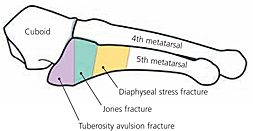5th Metatarsal Fracture
Metatarsal fractures are a common foot injury. This article will focus on fractures to the 5th metatarsal affecting the bone on the outside border of the foot. For information on other types of metatarsal fractures click here.
What is a 5th Metatarsal Fracture?
The most commonly injured is the 5th metatarsal also known as a ‘Jones fracture’.
The 5th metatarsal is located on the outside of the foot and joins to the little toe. Males fracture this bone more than females but the location of the fracture is different for each gender so much so that there is a significant correlation between gender and location. It is common in younger males but also common in older females.
The 5th Metatarsal is often fractured from ankle inversion injuries (sprained ankle) as well as direct trauma. Due to the attachment of the peroneus brevis tendon to the base of the metatarsal it is a potential site of fracture in that of an avulsion fracture.
The majority of fractures occur near the base of the metatarsal (closest to ankle). To help understand the management of these fractures the base can be divided into 3 zones – the tuberosity, the metaphysis and diaphysis.
The majority of fractures (non-displaced) can be managed conservatively but of note is an area between 2 arteries (metaphyseal and nutrient) that provides blood supply to the metatarsal that can be a risk for delayed and non-union fractures.



Fractures in the tuberosity have good healing potential and can be placed in a boot with the ability to weight bear from the start of immobilisation (as tolerated). Fractures to the other two areas will also be placed in a boot and mostly non-weight bearing for the initial period.
Some metatarsal fractures may require an orthopaedic referral. These include neck and shaft fractures with >10degrees of angulation, those fractures with >3mm of displacement, avulsion fractures with >3mm of displacement or non-union fractures especially in athletes.
To assist in the specific diagnosis of your fracture an Xray is essential.
Treatment for 5th Metatarsal Fracture
The key to getting a good result and returning to full function is early management. Activate Physiotherapy offer same day appointments to attend their fracture clinic to ensure your fracture is managed with the best management from the start. Following your Xray our Physiotherapists will fit you into a moon boot/walker.
Depending on your fracture and your pain you may be required to use crutches as well and not weight bear for a period of time.
Most metatarsals will require immobilisation for between 4-6 weeks. It is important to note radiographic evidence of healing can take months.
Common return to running time is around 3 months.
Our approach is unique and our physiotherapists understand the importance of integrating your rehab during the healing process and will assist you with a rehabilitation program at the various stages of your healing journey. This reduces the complications that often occur from foot fractures.

How to Make a Fracture Clinic Appointment
Making an appointment at our fracture clinic is as easy as booking online for your nearest Brisbane based Activate Physiotherapy clinic in Stafford or Gumdale.
No Xray? No problem!
We can arrange bulk-billed xrays to confirm diagnosis and monitor healing.
Need your cast removed?
We can help with that too! We are able to remove backslabs and full plaster or polyester casts
